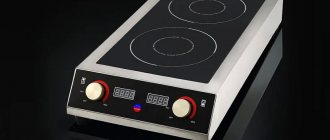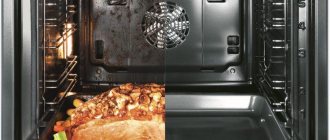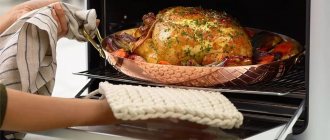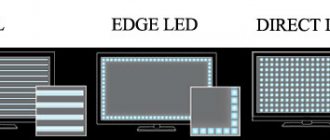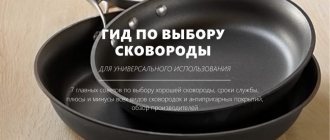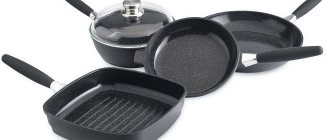Table Of Contents
- Frying pan-WOK - what is it
- Advantages and disadvantages of a wok pan
- Purposes of application
- Functions of a wok pan
- Types of wok pans
- Cast iron wok pan
- Metal wok pan
- Ceramic wok pan
- Diameter of frying pans-WOK
- Choosing a wok pan for the stove
- Gas stove
- Electric stove
- Induction cooker
- Types of coating for wok pans
- Wok-pans with stone coating
- Wok-pans with non-stick coating
- Criteria for choosing a wok pan
- Traditional Chinese wok
- Rules for caring for a wok frying pan
- Cleaning the walls of a wok pan from fats after cooking
- Features of recipes when cooking in a wok pan
- Frying vegetables in a wok pan
- Universal dishes in a wok pan
- How is a wok frying pan different from a regular frying pan?
Initially, the wok frying pan appeared on the territory of the Celestial Empire. It can often be seen in shops preparing various street cuisine dishes. The cookware is used in restaurants and at home, and it was invented by the poor Chinese because they tried to reduce the cost of the cooking process. The conical configuration was created to retain heat for a long time, and thick metal was also used. The result is quick cooking.
Frying pan-WOK - what is it
The dishes can be made of different metals, supplemented with coatings, the only thing that remains is the shape of the bottom part. The products are made this way for economical use of heat, cooking juicy and healthy food. The frying pans have round edges and allow you to fry in sunflower oil, grilled or steamed. Supporters of a healthy diet can cook without fat.
Important: It is possible to cook several dishes at once; in this case, the grill is used for steamed vegetables or curd desserts. Another use: Temporarily position finished foods to drain excess fat.
How to cook
When cooking food on this device, you should follow a few simple rules. These requirements will allow you to get the maximum benefit from this device:
- Food preparation must be done before cooking begins.
- Place food only in a hot frying pan.
- The harder the product, the thinner it is cut.
- When cooking, use only peanut (in liquid form), sesame or sunflower oil.
- In the midst of cooking, do not reduce the heat.
- Mixing is carried out in the direction from the center to the walls.
- When cooking several products together, the hardest and thickest cut ones are added first.
- When preparing hot dishes, pasta or rice should be boiled in advance (before adding to other ingredients).
- Cold ingredients are added to the pan gradually so that the temperature inside does not drop.
You cannot cook food using olive oil on this appliance. Butter is also inappropriate during the cooking process. It evaporates even before the food begins to fry.
As the information described above shows, a wok pan is a device that came to Europe from Ancient China, but has become popular here too. Modern manufacturers have adapted the tool for the average European user. If you properly care for this device, it will last a long time and will help you prepare many delicious dishes.
Prepare food in advance
Chop food finely
Place food only on a hot surface
Turning direction: from center to wall
All products are laid gradually
Advantages and disadvantages of a wok pan
The cookware has noticeable differences from the standard pan format. In this case, it is worth considering a number of nuances of use, but there are more positive qualities:
- possibility of simultaneous preparation of several dishes. This speeds up the cooking process;
- the shape promotes rapid heating, the main heating is concentrated at the bottom;
- since there is a similarity with a stewpan, boiling, stewing, frying, baking, frying, deep-frying, and using steam are allowed;
- Maximum heating rate is ensured, so less oil and time are required.
Important: When stewing, be sure to stir the ingredients and monitor the heat level.
Pans also have some disadvantages:
- the dimensions can be quite large, so the structure is difficult to place on the stove, and it may not fit into the oven;
- handles often get hot;
- using a metal spatula accelerates wear, especially with Teflon coating.
Purposes of application
The vessel copes well with stewing, frying, boiling, baking, and the food can be healthy, nutritious and juicy. The design is also suitable for making French fries. Vegetable stews, French meat, Uzbek pilaf and much more are excellent. The food needs to be stirred and water added. A wok often replaces a steamer; usually a grate is provided for this.
Functions of a wok pan
Basically, frying pans are designed for frying foods, but combined cooking methods, stewing, and boiling can be used. Such high functionality has led to an increase in demand. You can cook with little or no fat, and Chinese cookware is also great for cooking with sauces.
What is it for?
The word "wok" means "frying pan" in Chinese. The language has many words for a specific type of cooking, and wok is the process of frying in a special frying pan. This device has a number of features adapted for cooking:
- Rounded bottom - thanks to its unusual shape, the fire evenly touches the walls and bottom, heating them equally.
- Thin walls - because of this, the product is fried so quickly that it forms a crust, sealing the juices and nutrients inside it.
- The shape of the handle - during cooking you have to hold the frying pan directly above the fire, so the handles are often made long. Such devices have an additional small handle.
This device is used for various methods of cooking, but it is intended for frying foods. They should be processed at the highest possible temperature of 200 degrees. Dishes can be prepared with or without oil. To prepare food on such a device, it is recommended to use all kinds of sauces.
Types of wok pans
Nowadays a huge selection of types of tools is offered, they differ in coating, external data, and type of handles. Therefore, the purchase should be made taking into account your own requirements and wishes. The material used affects the appearance, heating rate and application features.
Cast iron wok pan
What is the difference between cast iron models? They have maximum strength and long service life. These types of cookware look good, have considerable weight, and are suitable for stoves and open fires. Due to the characteristics of the material, the pans take a long time to heat up, but retain heat well.
Metal wok pan
Aluminum is often the chosen metal; it must be combined with a non-stick coating. Such products heat up quickly, but when very high temperatures are reached, harmful substances can be released from the used coating. Stainless steel also heats up quickly, is lightweight and can last a long time.
Important: Steel frying pans must be used correctly; if you choose a low-quality product, deformations will gradually appear.
Ceramic wok pan
Ceramics are completely safe for food, provide high heating rates and are compatible with any stovetop. In this case, temperature changes are not allowed, and the material is also fragile.
Flaws
Asian cooking methods are becoming increasingly popular. Some people buy such a frying pan for home, but due to some of its shortcomings, the use of this tool becomes inferior or absent altogether. Therefore, before purchasing such a frying pan, you should be aware of its disadvantages.
Among them are:
- Non-standard sizes. Such a tool may not be located on every stove and not in every oven.
- The need to purchase special blades. The shape and coating of the frying pan require careful handling, so you won’t be able to use the item without additional tools.
- Ability to operate a pen. Not everyone can hold a frying pan filled with food. Some manufacturers make handles from low-quality material, and they heat up quickly. Cooking food in such a device becomes incomplete or even impossible.
Choosing a wok pan for the stove
The shape of the dishes was originally developed for Pan-Asian cuisine. At the same time, it is multifunctional and allows you to implement several methods of processing products. The convenience and taste of the dishes will depend on the choice.
Gas stove
The possibility of use on a gas stove must be specified by the manufacturer; usually all types of frying pans are suitable. An exception is products labeled “for electric stoves only.”
Important: Avoid frying pans with thin bottoms; they cannot withstand high temperatures.
Helpful Tips:
- A thick bottom is required.
- It is worth choosing a product with a diameter that matches the burner.
- An excellent option is to choose one that matches the burner you use for frying.
For gas stoves, grooves can be made to increase the heated area; they raise the temperature and speed up cooking.
Electric stove
Most models are suitable for electric stoves, but it is necessary to have a flat base equal to the size of the burner. Next, the sides bend and go up at an angle. It is worth considering the necessary dimensions, capacity, and equipment.
Including suitable:
- cast iron;
- aluminum with non-stick layer;
- stainless steel;
- ceramics.
Induction cooker
In this case, the slab is different from the usual one and requires the use of thick walls. Suitable steel or metals containing it, cast iron. There are no restrictions on the internal coating; Teflon, ceramics, titanium or stone coating are suitable. Models with enamel, nanocomposite or diamond coating are much less commonly used.
Important: If you buy cookware designed for induction heating initially, it will be easy to use and will last as long as possible.
What to cook in the Wok
Before cooking food in a wok, familiarize yourself with the principles of its use:
- to achieve maximum benefits, when frying using the stir-fry technique, products must be constantly stirred from the edges to the center;
- before frying, the frying pan with oil should be well heated until smoke appears, otherwise it will not fulfill its main functions;
- the components of the future dish should be cut into small slices or cubes;
- Do not throw too many ingredients into the container;
- Use only certain oils for frying (sunflower, sesame or peanut).
Using a Chinese frying pan you can cook original dishes, for example:
- wok noodles with chicken fillet and zucchini;
- rice pasta with seafood;
- beef with bell peppers and tomatoes;
- udon noodles with asparagus and carrots;
- fried shrimps;
- rice noodles with pork tenderloin;
- rice with seafood;
- noodles with oysters;
- deep-fried vegetables and meat;
- classic first courses;
- steamed vegetables.
If you want to cook delicious and healthy East Asian, as well as traditional Russian dishes, you should take care of buying a wok.
Types of coating for wok pans
When choosing, the type of coating is often taken into account; this is important because it has a significant impact on the cooking process as a whole. Also, the inside of the frying pan comes into contact with food and affects its quality and safety. If there is a high-quality coating, the dishes are considered more practical.
Wok-pans with stone coating
The products are characterized by a long service life, reliability, ease of maintenance and hygiene. The coating allows you to use metal objects for stirring: ladles, spoons, spatulas.
Product advantages:
- tolerance to temperature fluctuations;
- safety and environmental friendliness;
- attractive design;
- cooking with a minimum amount of oil or without it is allowed;
- ease of care;
- Dishwasher safe.
Wok-pans with non-stick coating
When using a Teflon coating, food is resistant to burning. The coating is often used for Asian and domestic cooking.
Important: Non-stick frying pans are not acceptable when using the street-fry method. They also do not fit into the concept of this category of tableware, since they do not reflect the original authenticity.
If you use strong heating, toxic fumes will form on the surface, which will negatively affect your health. At the same time, dishes with Teflon can be used in the kitchen, but for sautéing and stewing in the standard way. Do not heat the frying pan to very high temperatures.
How to “open” wok correctly? First launch of the steel wok
Before first use , to prevent food from sticking to the walls and burning, you need to apply a protective non-stick coating . To do this, the wok needs to be “opened” or as the Chinese call this process “hoi wok”.
There are more than 10 ways to open it. I’ll give you one example that is suitable for use at home.
If you don't want to read, there are two short videos below.
In order for your wok to serve you for as long as possible, you will need:
- Gas stove or burner
- Carbon steel wok without non-stick coating
- Refined sunflower oil
- Paper towels or napkins
Preparation:
- First, thoroughly wash the wok to remove any shipping grease, dust or other contaminants.
- After washing, boil water in a wok to ensure that any dirt on the inside of the pan is removed.
- The wok should not be greasy to the touch.
- Open the window in the kitchen and close the door to another room. Turn on the hood. There will be a lot of smoke.
And the process itself:
- A clean wok is set to maximum flame. We wait for the moment when the metal heats up and the color at the bottom changes. The color will shift to blue in the hottest areas.
- Slowly turning and tilting the wok around the flame, allow its walls to heat as well.
- After most of the surface has warmed up and taken on a blue tint, it’s time to add 80-120 ml of sunflower oil. The oil should cover the bottom in an even layer.
- Rotate the wok, tilting it to the sides so that the oil covers the entire area of the pan.
- When rotating, do not move the wok far from the flame. The pan should not cool down.
- After 3 minutes, turn off the heat.
- After 3 minutes, move the wok to the sink and cool first the outer part of the pan , and then the inside under cold water
- After cooling, turn the flame back to maximum.
- Heat the wok until the moisture evaporates.
- After this, add 30-50 ml of oil, spread it over the surface of the wok and heat until smoke appears.
- Turn off the flame.
- Take napkins or paper towels and, using a metal pot holder or other tools, lightly rub the oil into the inside of the wok. You can also go through the outside, this will protect the steel from corrosion in the future.
- Let the pan cool by leaving it on the stove
After creating this coating, do not wash the wok with detergents ! Now only warm water, a clean soft sponge or brush. The wok should always remain covered in a film of oil. This way the frying pan will serve you for many years.
If you did not temper the steel wok right away, you can do this later by cleaning the surface of the pan and repeating the steps above.
Detailed launch of the wok in the video in Russian. The blog is beautiful and tasty https://www.youtube.com/watch?v=uIf00JXpDYU
A shorter way to prepare a wok in this video. Here they use a torch, oil and paper towels.
Criteria for choosing a wok pan
When choosing, you should consider what the frying pan will be used for; the parameters will affect the aroma and taste. A wok with a convex firm bottom is considered a classic, while Western models are flat or close to flat. These adjustments are necessary because they allow the cookware to be used on electric or induction cooktops. The flat shape of the bottom ensures stability. Round models can be adapted to a modern kitchen, but additional stability rings are needed.
Traditional Chinese wok
Models of authentic shape are unusual and attractive, therefore, in addition to Asia, they have become widespread in Europe. The standard is a large round frying pan without a Teflon coating. This allows you to use burners and save on heating.
What to look for before purchasing
To make using a frying pan practical and correct, pay attention not only to the main selection criteria, but also to the configuration of the bottom, the size of the product and its configuration.
Bottom configuration
After you decide on the material of the pan and the type of coating, pay attention to the shape of the bottom. A traditional wok with a cone-shaped bottom is only suitable for a gas stove. In this case, you need to take care of purchasing additional rings for installing the pan on the burner. For any other hob (electric or induction), a product with a flat base is suitable.
Pan sizes
On sale there are both small containers from 15 cm in diameter, and huge ones up to 76 cm. For home use, you should not buy large frying pans, which will be bulky, inconvenient and not suitable for a regular stove. The optimal size of a frying pan for home is from 28 to 35 cm in diameter. In such a dish you can cook from 1 to 5 servings, while it is compact and easy to use.
Types of pens
Handles are also one of the most important criteria when choosing. In the assortment of woks you will find containers with one or two handles, which can be either cast or removable. Before purchasing, be sure to hold the device in your hand and think about which handle configuration will be more convenient for you to mix food during cooking.
Also pay attention to the material of the handles. Professional chefs prefer wooden handles that do not heat up during use.
Equipment
Some Wok models come with additional accessories. A nice bonus will be the lid, grill and wooden spatulas included in the set. The grill allows you to steam or deep-fry food, and use wooden utensils to preserve the non-stick coating.
Rules for caring for a wok frying pan
A new frying pan needs to be prepared; the process includes a number of steps:
- High-quality cleaning, removal of dust and dirt.
- Warming up for the purpose of glowing. The walls and bottom must be fired under high temperature until a dark shade appears.
- Filling the container with water.
- Repeating the cleansing process. It is necessary to pour out the water and rinse the pan outside and inside.
- Repeating the calcination process. The cookware should be placed on maximum heat.
- Use of oil. After darkening, you need to add vegetable oil, carefully distributing it over the surface.
- Turn off the heat source for approximately 3 minutes.
- Rinse with water and cool.
- Oil coating and reheating.
- Removing oil after smoke appears. Turn off the fire by removing the oil using paper napkins.
Important: This process is not performed with a non-stick coating, otherwise the cookware will be damaged.
It is better to use plastic spatulas and eliminate temperature fluctuations.
Cleaning the walls of a wok pan from fats after cooking
When performing cleansing, the following rules are provided:
- It’s better to stick to gentle cleansing formulations;
- washcloths should be soft;
- It is necessary to wash dishes after each use.
Important: Care details depend on the material and coating of the frying pan. Teflon does not allow sharp objects, and ceramics are easily damaged by impact.
Care Tips
The features of this cookware require special care to be taken. Here's what to do:
- Before first use, heat the instrument. Salt is used for this procedure. 25 grams of salt is enough for one pan.
- Before first use, the surface of the device is lubricated with edible oil. It serves as protection after calcination.
- Clean with care. For washing, do not use powders, metal scrapers or the abrasive side of a kitchen sponge.
- Wipe dry. Prolonged contact with water causes rust. To avoid damage to the instrument, it is recommended to wipe all parts dry after each wash.
- Avoid temperature contrasts. Washing should be done only after the item has cooled. A sudden change in temperature (which can be up to 200 degrees) can lead to deformation or cracks.
Must be heated before use
Wipe with oil
Mix food carefully
Features of recipes when cooking in a wok pan
In most cases, a wok is chosen for the purpose of quick frying; the method is also called stir-fry. The following possibilities are expected:
- deep fat formation;
- stewing vegetables and meat;
- cooking soups;
- steam cooking.
To obtain the desired taste and color of food, you need to take into account the features of the dishes. Fine cutting into identical components is recommended. Next, they are placed in the recess one by one, taking into account the time required for cooking.
Important: Stirring is necessary, especially at maximum heat. It is believed that this is how food retains its properties.
Frying vegetables in a wok pan
Vegetables can be boiled or stewed. If deep frying is used, oil is filled to 2/3 or ½ capacity. Deep frying provides an appetizing crust and allows you to achieve attractive taste.
Universal dishes in a wok pan
If the street-fry technique is used, models with one handle will be suitable. Most dishes can be prepared within 10-25 minutes. Cooking in this format allows you to preserve nutrients and vitamins; food is considered healthier than cooking in a standard frying pan. The reason is separate portioned frying, each ingredient is prepared in a small portion, it can be done in 3-5 minutes.
Important: If you need to minimize fat consumption, just use a spoonful of oil; the excess is absorbed into the walls.
During high-speed frying, a protective crust is formed, and the meat and vegetables inside remain juicy.
My opinion about wok
After purchasing this frying pan, I never regretted it, even though I bought an aluminum wok with a non-stick coating. The dishes turn out juicy, crispy and crispy, and are prepared quickly and easily. Vegetables and meat look very appetizing after quick frying. A regular frying pan is inferior to a wok in almost everything.
During the first preparations, of course, it didn’t work out very well. Either the meat would burn, or instead of frying, everything would start to stew. But over time, I got better at it, and everything started to work out.
I began to notice that the wok was gradually “displacing” a regular frying pan in frying. I will definitely order myself a real carbon steel wok in the future. There will be more pasta recipes ahead, prepared in this convenient bowl.
I look forward to your additions and comments to the article in the comments. See you!
How useful is the publication?
Click on a star to rate!
Average rating 4.4 / 5. Number of ratings: 92
No ratings yet. Be the first to rate.
How is a wok frying pan different from a regular frying pan?
The wok differs from standard frying pans in the presence of rounded walls; initially, an exclusively convex bottom and thin high walls were provided. There are two handles, there are models with one handle. Popular materials are carbon steel and cast iron; modern variations have expanded the list of shapes and materials.
In China, cooking is often done using specialized burners, so round-bottomed cookware is ideal. There is a recess in the center that ensures stability, and due to the powerful flame, heating occurs very quickly.
How to choose a quality wok
When purchasing, you should consider the following parameters:
- manufacturer company;
- material for the body and handle;
- coating;
- availability of additional functions;
- bottom shape;
- diameter;
- handle fastening.
It is believed that food prepared in WOK is distinguished by its taste and naturalness.
History of wok noodles
According to one version, the wok appeared in Canton, and after that it traveled a long way to get to Russia. A huge cone-shaped thin-walled frying pan with a slightly rounded bottom was a traditional kitchen utensil in China, and then among nomadic peoples. Its great advantage was that the food in it was cooked very quickly.
Woks were used by poor people who did not have the opportunity to install expensive stoves, and had to heat their own special small stoves with grass and straw, which burned quickly and did not provide too much heat. For the same reason, the wok took root among nomads. The bottom, which was small in diameter, had time to heat up to the required temperature, transferring the necessary heat to the high walls.
Noodles were also considered the food of the common people. It was used along with cooked rice, soybeans and wheat. With the advent of the wok, it practically replaced them from the diet, mainly due to the simplicity and speed of cooking. Boiled pieces of Mien Pien dough used to be completely fried in a wok, only centuries later did the noodles acquire the appearance we are familiar with. According to one legend, it symbolizes longevity, so the longer the noodles, the better.
Recipes
Now that a successful purchase has been made and the frying pan has gone through the “opening” procedure, feel free to begin culinary masterpieces. So, what can you cook in a wok in 12-15 minutes? The list is long: they prepare pilaf, vegetable stew, roast, cook soups, create fries. And this is not a complete list of dishes that you can easily cook in your new frying pan. The recipes below will help you master cooking technology.
Zucchini soup
Peculiarities. This soup does not contain heavy or unhealthy foods. Therefore, it can be safely classified as a healthy dietary dish.
Ingredients:
- carrots - half a root vegetable;
- onion - one head;
- zucchini (small) – one;
- champignons – 200 g;
- sunflower oil – one or two tablespoons;
- tomato - two fruits;
- water – one and a half liters;
- herbs, spices, sour cream.
Preparation
- Initially, prepare all the ingredients: chop the onion; grate carrots, zucchini; cut the champignons, chop the tomatoes.
- Pour oil into the frying pan and wait until it gets hot.
- Add foods to the wok in the following order: onions, then carrots, followed by champignons, zucchini.
- When these components have simmered a little, add the tomato and chopped herbs.
- Pour boiling water into the pan and cook for a couple of minutes.
- Turn off the heat, cover the soup with a lid, and let the dish brew.
- When serving, add sour cream.
Fragrant risotto
Peculiarities. This dish will allow you to “touch” a little of the delicious and spicy Italian cuisine. You can adjust the spiciness yourself, taking into account your taste preferences.
Ingredients:
- ham – 240 g;
- dry red wine – 0.75 l;
- rice - one glass;
- sunflower oil – 25-30 ml;
- champignons – 150 g;
- red pepper (bitter) - a quarter of a pod;
- saffron, spices;
- water – 220 ml;
- hard cheese – 50 g.
Preparation
- Cut the ham, chop the champignons.
- Pour oil into a frying pan and heat it.
- Add the ham to the wok.
- Next add the champignons and simmer a little.
- Add rice and immediately pour wine over all ingredients.
- Stirring constantly, simmer the risotto until all the alcohol has evaporated.
- Add chopped red pepper (if you don't want a spicy dish, you can omit the chili).
- Season with saffron and spices.
- Pour in water and continue to simmer for another 20 minutes.
- Before serving, garnish the dish with grated cheese.
Healthy food lovers cook healthy steamed dishes in a wok pan. It's even easier. You need to pour water into the pan and insert a wire rack. Lettuce leaves are laid on it, meat, vegetables, and fish are placed on top. The entire structure is covered with a lid. If we are talking only about vegetables, then 30-45 minutes are enough for them to be ready. It may take 30-60 minutes to cook the fish. And it takes, on average, two hours to cook meat.
Video on the topic
WOK noodles in a box
In many films, Chinese noodles are eaten not in restaurants or at home, but on the street or in a car from cardboard boxes. It is sold in take-away cafes and even from wheels and carts on the street. Such noodle boxes were invented not by the Chinese, but by the Americans. When the fashion for Chinese noodles came to them at one time, they made it an analogue of fast food, and instead of original packaging they began to use oyster boxes. It was for this sea delicacy that the boxes were originally designed and manufactured.
Selling oysters as a quick snack has become unprofitable; prices for shellfish have skyrocketed. But from the skies came a worthy analogue. Boxed noodles not only took root in America, but also became an independent dish and were warmly welcomed in many countries.
Basic rules for cooking in a pan
To ensure that the food in the amazing dishes is well cooked and evenly heated, follow these tips:
- For cooking, food is cut into pieces of approximately the same size. The optimal size is considered to correspond to one bite. If you make the pieces large, they will turn out nice and fried on top, but raw on the inside. Initially, fine cutting was chosen for quick cooking and fuel economy.
Frying vegetables in a wok
- If you need to cook several ingredients at the same time, put those that take longer to cook first. The products are added gradually and stirred constantly.
- The meat is most often cut into thin strips, with cuts made across the muscles.
Cooking meat in a wok
- Only a small part of the pan heats up to maximum during cooking. Heat spreads upward from it. In order to ensure uniform heating of the products, they must be stirred constantly. This can be done with special devices. It is taken into account that metal utensils cannot be used for non-stick coating. In the homeland of the Vogue frying pan, culinary virtuosos mix food while tossing it.
The ingredients in the wok are mixed by tossing
- The small shape of the container does not contribute to heating a large number of ingredients. It is difficult to ensure their uniform heating, so they add a small amount of food. In this container, food is most often prepared for one time.
Do not put large amounts of food into the wok
Slab compatibility
Manufacturing materials influence the technique and timing of preparation of a particular dish. Before purchasing, you should study the characteristics of the product, which will confirm its interaction with an induction or electric stove.
Aluminum. It heats up in a short period of time, but without regular stirring the food will burn.
- Can be used on a gas or electric stove.
- Without a non-stick coating, the utensils will quickly deteriorate.
- Among the privileges are low cost and light weight.
Steel. High-quality and durable material of high cost.
- However, the variety of components must be taken into account.
- For example, a manufacturer may combine the base material with aluminum, chrome or copper.
- But coverage is much more important. The most valued is pure stainless steel, which does not deform during operation, despite the thin bottom.
- The thick bottom guarantees a long service life, but it will take longer to warm up.
- The product can withstand low and high temperatures, preserving nutrients.
- Uncoated steel cookware is available on the market at an affordable price, is lightweight and has good thermal conductivity.
Cast iron. Impresses with high quality roasting thanks to its perfect non-stick property.
- The downside is that the frying pan is fragile or heavy.
- Thin options warm up faster, but can crack at any time.
- Heavy products are highly durable.
- But thanks to the thin sides, some dishes can be shaken for a sophisticated taste.
- This is impossible to do in heavy dishes.
